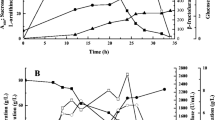Summary
Sugar beet molasses was used as carbon source forSaccharomyces cerevisiae growth and as substrate for bioconversion to fructose diphosphate. The highest level of fructose diphosphate (26.6 g/L) was reached after 10 h incubation of permeabilized cells under appropiate molasses and phosphate to cell ratio and represented a 64% yield of bioconversion.
Similar content being viewed by others
References
Bergmeyer, H.U. (1984) Methods of enzymatic analysis. Basel: Verlag Chemie, pag. 1314–1319
Bisso, G.M. and Melelli, F. (1986) Process Biochem. 21, 113–117
Carlson, M. (1987) J. Bacteriol. 169, 4873–4877
Compagno, C., Tura, A., Ranzi, B.M., and Martegani, E. (1992) Appl. Microbiol. Biotechnol. 36, 535–537
Markov, A.K., Don Turner, M., Oglethorpe, N.C., Neely, W.A., and Hellems, H.K. (1981) Surgery 90, 482
Melelli, F., Tommasi, A., and Bisso, G.M. (1989) Biotechnol. Lett. 2, 669–672.
Author information
Authors and Affiliations
Rights and permissions
About this article
Cite this article
Compagno, C., Tura, A., Ranzi, B.M. et al. Production of fructose diphosphate by bioconversion of molasses withSaccharomyces cerevisiae cells. Biotechnol Lett 14, 495–498 (1992). https://doi.org/10.1007/BF01023174
Issue Date:
DOI: https://doi.org/10.1007/BF01023174



